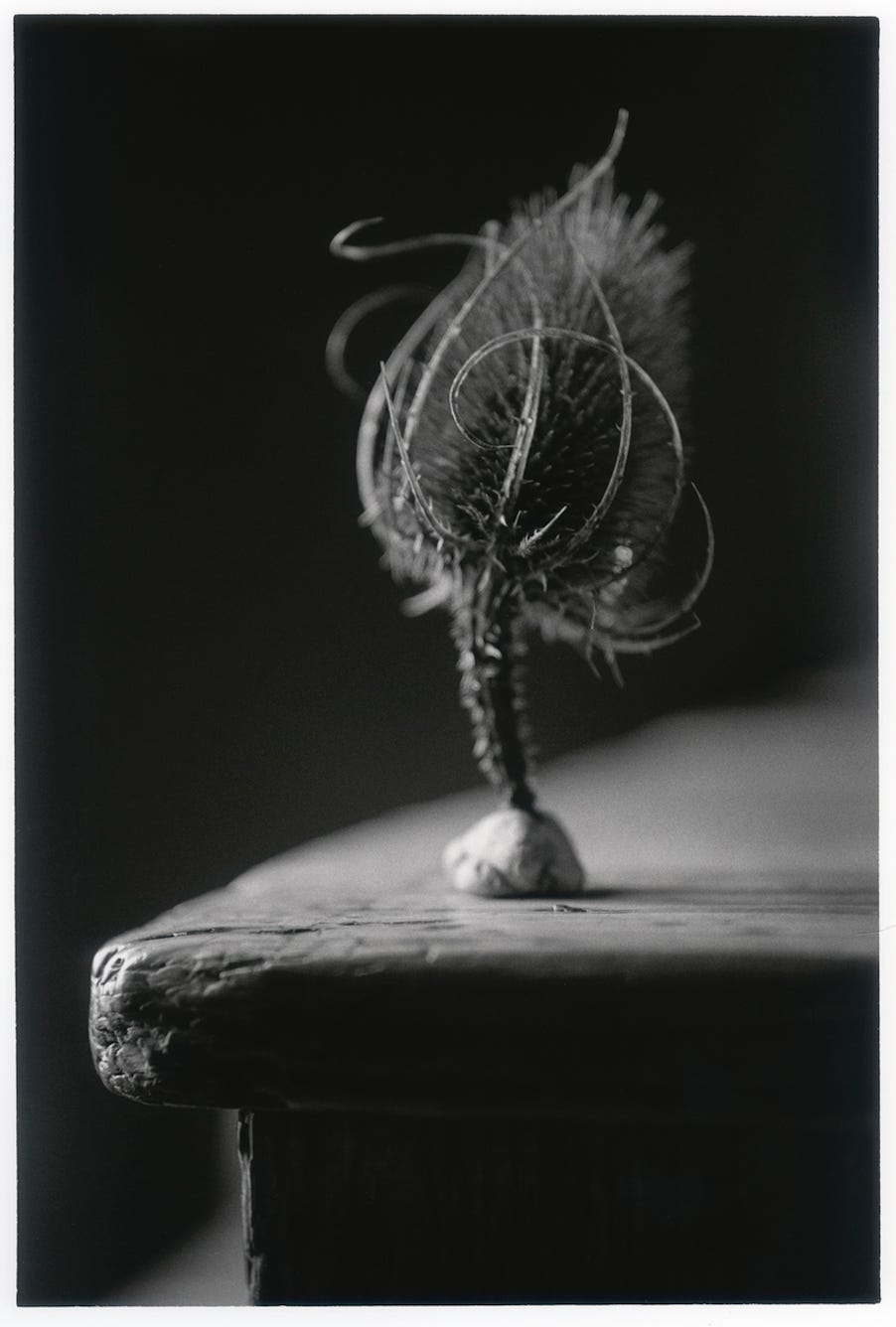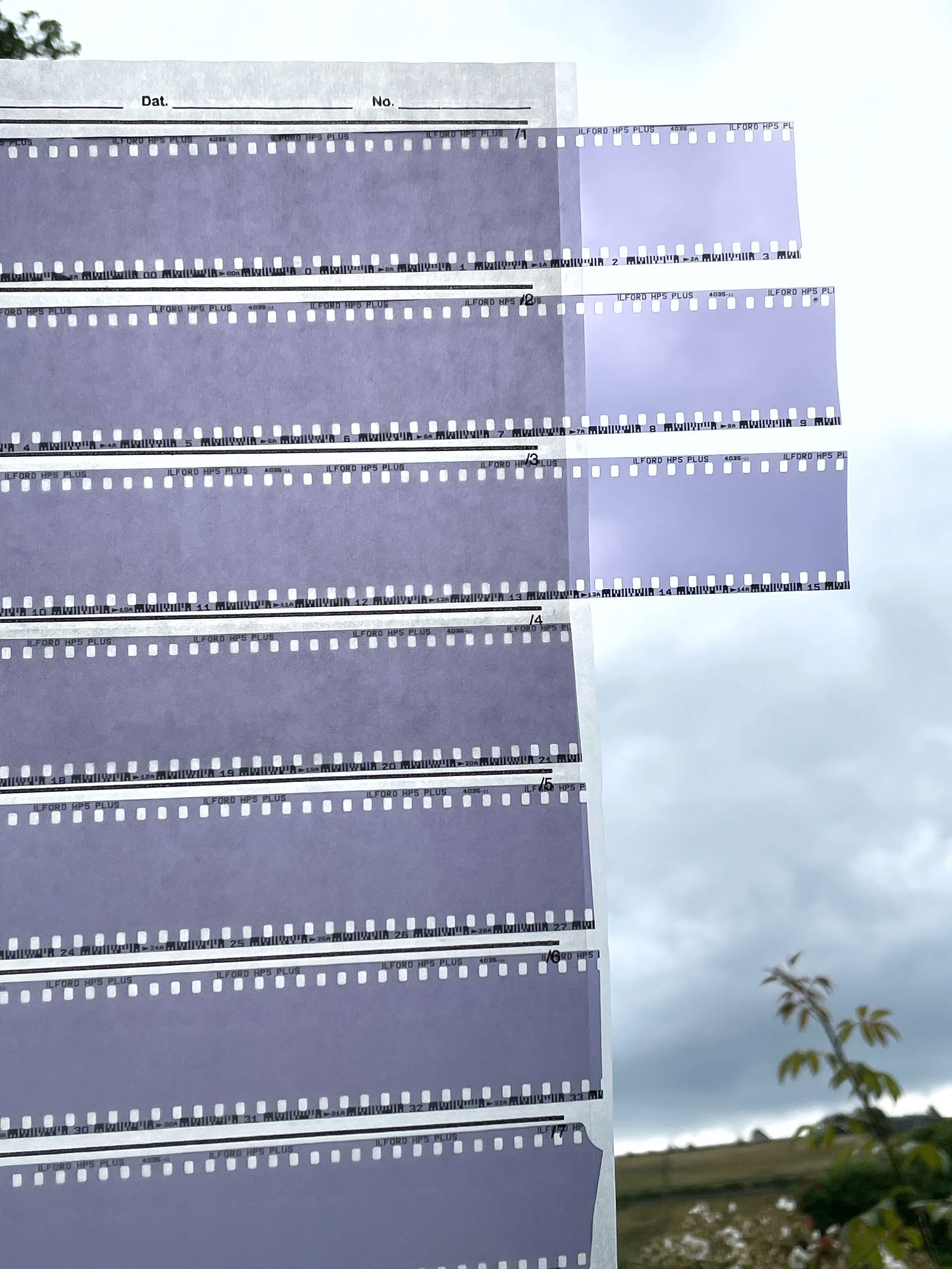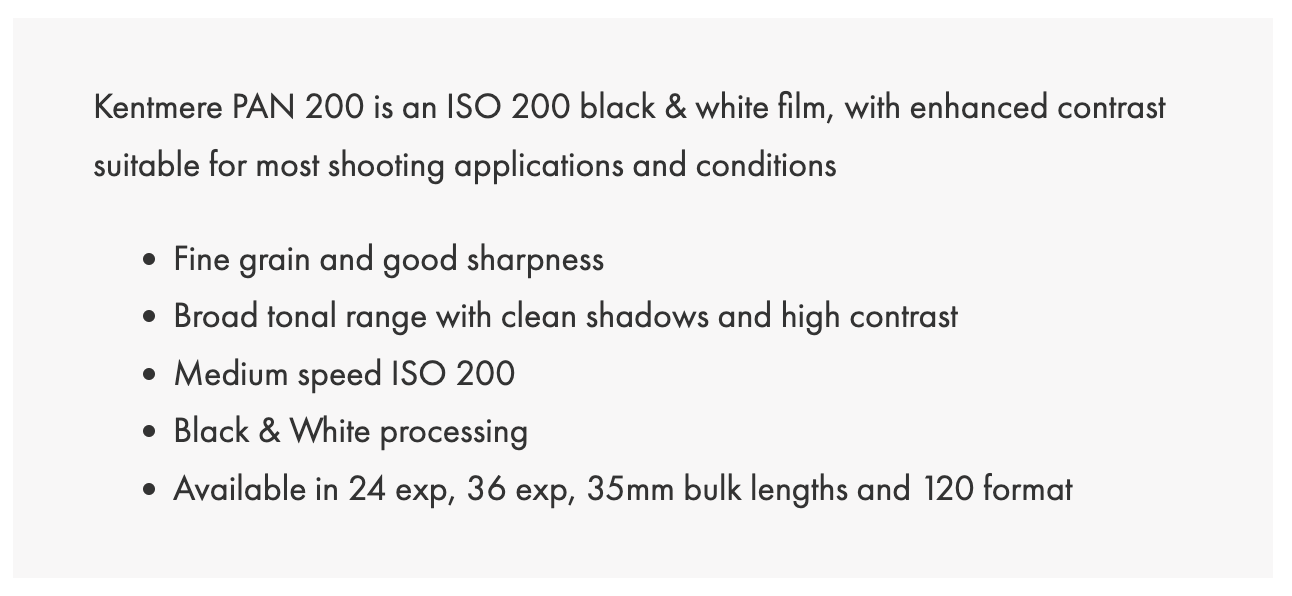In the last year I have seen online, two photographers comment on a film stock they had tried. Both said something to the effect of: 'This film has great blacks!'
Can anyone spot the ignorance of that statement?
My first thought was that these two, and probably many more have absolutely no concept of what is going on in the camera/dev tank. The part of the film that gives a black to the image, is the clear, unexposed parts - the blank, empty part of the negative. So they are effectively saying: 'I love this film, it has great blank bits'.
I’ll tell you what else gives great blacks; A piece of cling film, a sheet of glass, a bit of plastic from a cheap bottle of water. You could even try putting nothing in your enlarger and then exposing the paper, -that gives the best blacks of all!
Don’t believe all you read.
There are a lot of myths in photography, a lot of poorly thought out advice and a fair amount of bullshit. Having an ability to see your way through this stuff will make your job as a photographer/printer much easier. Photography is both a science and an art. The science bit is logical, it makes perfect sense and if something goes wrong you can work it out and avoid it next time, (or use the effect creatively sometime). The more you get clarity on what is actually happening, the less mistakes you will make. You don’t have to have a degree in chemistry, but you need to know the principles and what is supposed to happen.
Try to understand the cause and effect of it; ‘If I give more exposure, the shady bits under the tree will begin to affect the film/If I leave it in the developer too long, the heavily exposed parts will develop to a black, and no light will pass through, either in the darkroom, or on the scanner. My whites will have no detail’.
The art part comes from you. How you think about your photography determines the images you produce. If you don’t do it often enough this part doesn’t come naturally. Luckily, seeing can be done anywhere, anytime, no matter what is happening in your life (tragedies, bereavements and disasters aside), so you should practice it.
You can be looking at the effects of light, you can be observing shapes and possible compositions. You might not have a camera with you when you notice this stuff, but the noticing is the important part. Do it in your head and get used to thinking that way. To practice the art of composition you could always do a quick shot on your phone if circumstances allow.
Confusion.
There is a lot of confusion in photography, I have experienced it myself. I made assumptions and the results were not what I expected, I had to reevaluate my ideas about what I wanted and how it was going to affect the picture. I lost images, or ended up with difficult negatives as I learned what was happening.
Contrast is a case in point, and one which confuses a lot of people, even the professionals. This is from the Ilford website;
Ilford have been promoting the new Kentmere 200 recently as a high contrast film, and then stating in the promotion that it has a broad tonal range, but how can a film be high contrast and have a broad tonal range? You can’t have both.
I remember when I first heard about the developer Pyrocat HD many years ago, it was claimed that it gave a longer tonal range because the highlights didn’t block up, as they can do with many common developers (this is caused by overdevelopment alone and is not a feature of any film). I shot some FP4 of my kids one day in all sorts of lighting conditions and when I made prints from the negs I was disappointed, they looked flat. It didn’t take long for me to realise that I had exactly what I had wanted, a long tonal scale, but I was interpreting that as flat. Be careful what you ask for.
You can’t have a film that gives a long tonal range from deep shadow to sunlit whites without the tones in the middle looking flat. What you want is some brightness and tonal separation in the mid tones, but plenty of highlight detail, and no film does that on its own. The answer is to have a negative with an exposure that reveals some shadow detail, and which is developed to the point where the heavily exposed areas are not too dense. The separation in the middle tones then is done in the darkroom with a slightly punchy filtration, say grade 3, then the sky is burned in with a grade 1. That will give you sparkling images.
Don’t get lazy.
My dislike of digital photography for my own use comes partly from the sterile look it gives, but also because it makes a photographer lazy. There is a lot that you don’t have to pay attention to, such as focus and exposure, and shooting on RAW gives you a lot of scope for error as we all know.
If you want a sense of satisfaction from your photography, don’t go for easy options. Ideally you need to overcome some problem and the successful result makes you feel that you have achieved something. ‘It doesn’t matter what you shoot on, it’s the end result that matters’ -Yeah right. The people who say that are always the ones who take the lazy option, and whose work is average at best.
Think about what you are doing, question the information you have found or been told, for instance; ‘Bang your developing tank on the table to dislodge bubbles’.
Try that with a tank with an empty spiral, but with your usual developer (you could save some from the last process you did), see if it dislodges any bubbles. It’s really not that effective, and you risk cracking the tank. What are you going to do if developer starts leaking out of your tank during processing?
‘High pressure washing will remove fix faster’ No it won’t, fix leaches out at a rate dependent on the volume of water surrounding it. Once the emulsion and the water are equal as regards fix saturation, it stops. Put fresh water around it and the fix migrates to the clean water until equilibrium is reached again. Regular changes of water with rest periods in between will do a very good job.
Male jewelry.
Do you need a Leica to be a good photographer? Does owning one improve your photography? Of course not. I bought a folding 6x6 Zeiss Ikon Nettar for £15 from a camera fair and it will produce images far sharper than any Leica. It’s also quite a bit lighter to carry around too. Don’t believe the hype. If you are walking about with a Leica it’s because you want people to see you are a photographer.
Be aware.
Be aware of light, be aware of shapes, be aware of what your lenses can do. Be aware of picture possibilities every day. This will allow you to see your finished pictures in your head before you lift the camera.
My own awareness was a slow train coming until I was nearly 50, but now I’m committed to it all day, every day (until the dementia begins to kick in). I found that the more I paid attention, the better things got. I’m sure we all know people who make the common mistakes of leaving the lens cap on, not remembering that the camera is empty, forgetting to set the right film speed, leaving the box of paper open when they put the light on. It’s all about paying attention. This is why film photography separates the men from the boys (or the women from the girls?). Shooting large format for instance, can’t be undertaken by anyone who is a bit dippy and dopey. Dark slides get left in, shutters are left open, movements are a mystery.
On the subject of large format, photographers who use it don’t crop their images. Of all the formats that could be cropped, and still keep a reasonable quality, large format is the best, so why is it frowned upon? If I said that I shot on 10x8, then cropped my images to a quarter of the negative area, there would be cries of heresy! But if I took two camera backs out in the field and did one shot on 10x8 and one on 5x4, that would be ok. Ludicrous.
One more thing before I go; If you are going to think for yourself, don’t read the papers or watch the news. It’s all opinion, not facts. You are being told how to think.
Stay observant, stay objective and inquisitive. My mantra for many years has been; See clearly, think clearly, understand.
If you find my articles interesting or useful, please spread the word to anyone you can think of who would be interested.
If you have enjoyed this post and the information here and elsewhere on my Substack and you would like to support me, you can subscribe or just buy me a coffee at Ko-fi.com/andrewsandersonphotography You can send as little as £3.00, or more if you are feeling generous. This money goes towards materials used for the tests and printing for these articles. Alternatively you can be a paid subscriber.
Thank you for reading, please let me know your thoughts.
Andrew Sanderson July 2025.











Ha. It wasn’t me, was it? I’d certainly stand by that I like to shoot ortho film to get a unique tone in the image because of its specific sensitivities. But… annoyed with the price of ortho over here and armed with knowledge, the answer is to get a filter that will have a similar effect, and then pushing a little. A nice one time purchase that saves in the long run.
I find marketing stuffs to be avoided generally. There’s a disconnect between practice and the things that are written to generate attention or sell stuff.
Male jewelry is hilarious.
Some young film photographers say things all the time that show their lack of knowledge. I try to remember that I was once young :). I had to chuckle about leaving the paper on the enlarger for full blackness! I agree wholeheartedly with a number of points made here apart from one: I don’t think it’s fair to say that digital photography makes photographers lazy, at least not as a blanket statement and definitely not in my case. I see digital photography as a total separate exercise and art from my print work. I also spent quite a bit of sandwich time (film only for a while, followed by digital, then back to film) and found that digital enhanced my understanding of the exposure triangle, among other things. This made me understand how to shoot and see a negative a little better. Regarding washing, I was taught to rinse and dump in succession. I have yet to find any flaw to this method.